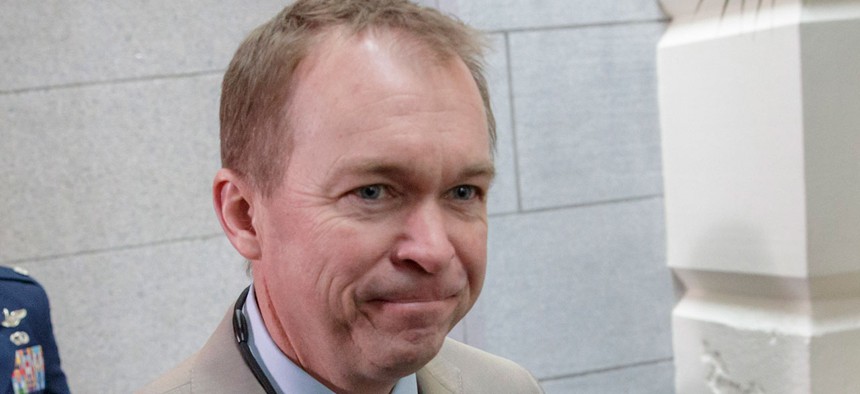Trump Ends Federal Hiring Freeze, but Workforce Cuts Loom
In issuing guidance for reductions, OMB director tells feds not to focus on who will be fired.
The Trump administration announced its hiring freeze will end Wednesday, while delivering to agencies promised guidance on how they should reduce the size of their workforces in both the near and long term.
Trump’s hiring freeze, which went into effect Jan. 23, lasted 79 days, with the Office of Management and Budget issuing guidance to end it 11 days before the president’s initial deadline. While agencies are allowed to begin hiring again without restriction or approval from the Office of Personnel Management, OMB Director Mick Mulvaney said Tuesday they cannot begin onboarding employees “willy-nilly.”
Agencies will replace the freeze with a “smarter, more strategic” plan for hiring, Mulvaney said, while developing policies to reduce the size of their overall workforces. The director said not every agency will see workforce cuts, though the new guidance specifically asks agencies to develop plans to reduce employees both immediately and in the future. The presidential memorandum Trump signed to implement the hiring freeze called for OMB and OPM to issue a long-term plan to cut the federal workforce through attrition. It also allowed for agencies to fill large swaths of vacancies through a series of exemptions to the freeze.
Agencies must deliver to OMB a preliminary, “high-level” draft of their reform plans by June 30, including a report on progress on near-term workforce reduction and a “plan to maximize employee performance.” In September, after discussions with OMB’s Resource Management Offices, agencies will submit their final reform plans and long-term strategies for workforce cuts as part of their fiscal 2019 budget proposals.
For the June proposals, OMB directed agencies to react to Trump’s fiscal 2018 budget to identify where to make workforce cuts. The administration advised agencies to begin implementing them immediately.
“Agencies should begin planning for these reductions now, as achieving associated personnel reductions takes time to implement and realize savings,” Mulvaney wrote in his guidance.
OPM will provide “streamlined templates” to enable agencies to request Voluntary Early Retirement Authority and Voluntary Separation Incentive Payments, or buyouts, that enable the human resources agency to approve the requests within 30 days. Mulvaney encouraged agencies to begin “eliminating unnecessary vacant positions” immediately, as well as to review whether employees currently on administrative leave because of performance or misconduct should be allowed back to work.
OMB laid out a series of guidelines for determining how to eliminate positions in the long term:
- Use data-driven workforce planning: Agencies should examine “various data sources” to determine “how many people are required to perform tasks” rather than simply going off the previous year’s numbers.
- Determine total personnel cost: In searching for efficiencies, OMB said simply looking at staffing levels “may not present the full picture.” They should consider consolidating higher-grade positions and downgrading management-level positions.
- Revise organizational design: Agencies should ensure they have the “fewest amount of management layers needed to provide for appropriate risk management, oversight and accountability.”
- Streamline policy creation: OMB suggested agencies look at potential redundancies at the component or regional levels.
- Review positions as they become vacant: Agencies should verify that each job that comes open “reflects current mission needs.”
- Ensure positions are still relevant: OMB said some jobs may have become obsolete because of technology, especially in “fields undergoing rapid transformation” such as database administration, invoice processing and financial management.
Mulvaney discouraged federal employees from feeling upset about the pending cuts, saying that ridding the workforce of unnecessary workers and poor performers will create more opportunities to recognize top civil servants.
“I think it’s wrong to say that because we’re reducing the overall size of government, as part of this, consistent with our budget, that everyone should just focus on who is getting fired,” Mulvaney said. “That is the wrong message to take from this.”
Aside from the Environmental Protection Agency, where Trump, through his budget, has already proposed eliminating 3,200 jobs, Mulvaney said OMB will not prescribe specific targets for cuts and declined to elaborate on how layoffs may ultimately factor into their plans. He acknowledged some of the reforms the administration would like to see would require congressional approval, but said in some cases agencies can act more quickly.
“Some places have the ability to reduce size immediately and they may be called upon to do that in order to line up with the president’s priorities,” Mulvaney said. “There may be other places where they don’t have that flexibility and they’ll have to figure out a way over the course of time through ordinary attrition to get to where they need to be.”
Before agencies submit their long-term plan for cuts, they must first turn in proposals to maximize employee performance. Those plans must include hiring and retention reform proposals, as well as address the removal of poor performers. OMB told agencies to “provide transparency” for the performance improvement plan process.
OMB's guidance provides for additional training for Senior Executive Service members and other supervisors on “managing employee performance and conduct.” Agencies must tell OMB how they will hold managers accountable for employee performance and submit a plan to create “manager support boards” that will provide expertise to supervisors on employee and labor relations.
Mulvaney said Tuesday the guidance demands that agencies examine broader personnel reform issues.
“That is one the things we’re asking agencies to look at,” he said. “How do you restructure your personnel policies in order to point out people who are doing a great job and figure out a way to get people who are not delivering money to the taxpayer, get them on board with whatever policy you’re trying to achieve?”
He added such an approach would ultimately improve employee morale.
“One of the frustrations government workers have is we don’t reward those who do a really good job and we don’t punish those who do a really bad job,” Mulvaney said.




